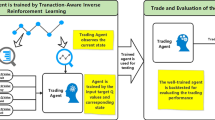Abstract
Investors who intend to execute large orders have to always a trade-off between price impact and opportunity cost in Big Data. In this study, reinforcement learning (Q-learning) is applied, due to its strength to support an agent, to make the best decision and take suitable action in a dynamic environment to achieve an optimal way to execute a large number of orders in a day trade. Through Q-learning algorithm, the agent has learned the kind of order yet by how much of it should be submitted in each step to achieve the optimum volume-weighted average price, as the objective function of learning in this study. Historical data of shares in Tehran Stock Exchange has been used to consider the possibility of order types to set the parameters of the simulated trading market, and the price impact on large orders has also been considered through this simulated Big Data to make it with higher accuracy. Results show that for a large order both on buy-side and sell-side separately, execution strategy adopting with multiple order types could be more appropriate compared with using a single order type of execution strategy. This case study suggests that passive order type leads the trader to achieve better results. Compared to the market, the optimal strategy has managed to reduce the volume weighted average price (transaction costs) by 0.95 percent on buy-side and increase it 1.31 percent on sell-side.





Similar content being viewed by others
References
Kissell, R., Glantz, M., & Malamut, R. (2003). Optimal trading strategies: Quantitative approaches for managing market impact and trading risk.
Cui, W., Brabazon, A., & O’Neill, M. (2011). Dynamic trade execution: A grammatical evolution approach.
Johnson, B. (2010). Algorithmic Trading & DMA: An introduction to direct access trading strategies (Vol. 200). London: Myeloma Press.
Bertsimas, D., & Lo, A. W. (1998). Optimal control of execution costs. Journal of Financial Markets,1(1), 1–50.
Moazeni, S., Coleman, T. F., & Li, Y. (2010). Optimal portfolio execution strategies and sensitivity to price impact parameters. SIAM Journal on Optimization,20(3), 1620–1654.
Schmidt, A. B. (2010). Optimal execution in the global FX market. The Journal of Trading,5(3), 68–77.
Almgren, R., & Chriss, N. (2001). Optimal execution of portfolio transactions. Journal of Risk,3, 5–40.
Alfonsi, A., Fruth, A., & Schied, A. (2010). Optimal execution strategies in limit order books with general shape functions. Quantitative Finance,10(2), 143–157.
Predoiu, S., Shaikhet, G., & Shreve, S. (2011). Optimal execution in a general one-sided limit-order book. SIAM Journal on Financial Mathematics,2(1), 183–212.
Forsyth, P. A. (2011). A Hamilton–Jacobi–Bellman approach to optimal trade execution. Applied Numerical Mathematics,61(2), 241–265.
Obizhaeva, A. A., & Wang, J. (2013). Optimal trading strategy and supply/demand dynamics. Journal of Financial Markets,16(1), 1–32.
Lin, Q., Chen, X., & Peña, J. (2015). A trade execution model under a composite dynamic coherent risk measure. Operations Research Letters,43(1), 52–58.
Guo, X., & Zervos, M. (2015). Optimal execution with multiplicative price impact. SIAM Journal on Financial Mathematics,6(1), 281–306.
Cartea, Á., & Jaimungal, S. (2015). Optimal execution with limit and market orders. Quantitative Finance,15(8), 1279–1291.
Admati, A. R. (1985). A noisy rational expectations equilibrium for multi-asset securities markets. Econometrica: Journal of the Econometric Society,53, 629–657.
Biais, B., Hillion, P., & Spatt, C. (1995). An empirical analysis of the limit order book and the order flow in the Paris Bourse. Journal of Finance,50(5), 1655–1689.
Glosten, L. R., & Milgrom, P. R. (1985). Bid, ask and transaction prices in a specialist market with heterogeneously informed traders. Journal of Financial Economics,14(1), 71–100.
Chakravarty, S., et al. (2001). Hidden order in the cuprates. Physical Review B,63(9), 094503.
Huitema, R. (2014). Optimal portfolio execution using market and limit orders.
Hendricks, D., & Wilcox, D. (2014). A reinforcement learning extension to the Almgren-Chriss framework for optimal trade execution. In 2104 IEEE conference on computational intelligence for financial engineering & economics (CIFEr), 2014. IEEE.
Cont, R., & Kukanov, A. (2017). Optimal order placement in limit order markets. Quantitative Finance,17(1), 21–39.
Chen, Y., Li, D., & Gao, D. (2017). Optimal order exposure in a limit order market.
Agliardi, R., & Gençay, R. (2017). Optimal trading strategies with limit orders. International Journal of Theoretical and Applied Finance,20(01), 1750005.
Cui, W., & Brabazon, A. (2012). An agent-based modeling approach to study price impact. In 2012 IEEE conference on computational intelligence for financial engineering & economics (CIFEr). IEEE.
Gao, X., Shatin, H., & Chan, L. An algorithm for trading and portfolio management using Q-learning and sharpe ratio maximization.
Berkowitz, S. A., Logue, D. E., & Noser, E. A., Jr. (1988). The total cost of transactions on the NYSE. The Journal of Finance,43(1), 97–112.
Keim, D. B., & Madhavan, A. (1997). Transactions costs and investment style: an inter-exchange analysis of institutional equity trades. Journal of Financial Economics,46(3), 265–292.
Harris, L., & Hasbrouck, J. (1996). Market vs limit orders: the SuperDOT evidence on order submission strategy. Journal of Financial and Quantitative analysis,31(2), 213–231.
Cartea, A., & Jaimungal, S. (2016). A closed-form execution strategy to target volume weighted average price. SIAM Journal on Financial Mathematics,7(1), 760–785.
Acknowledgements
This work is supported in part by the National Natural Science Foundation of China under Grants 61632009 & 61472451, in part by the Guangdong Provincial Natural Science Foundation under Grant 2017A030308006 and High-Level Talents Program of Higher Education in Guangdong Province under Grant 2016ZJ01.
Author information
Authors and Affiliations
Corresponding author
Additional information
Publisher's Note
Springer Nature remains neutral with regard to jurisdictional claims in published maps and institutional affiliations.
Appendix
Rights and permissions
About this article
Cite this article
Javadpour, A., Saedifar, K., Wang, G. et al. Optimal Execution Strategy for Large Orders in Big Data: Order Type using Q-learning Considerations. Wireless Pers Commun 112, 123–148 (2020). https://doi.org/10.1007/s11277-019-07019-0
Published:
Issue Date:
DOI: https://doi.org/10.1007/s11277-019-07019-0





